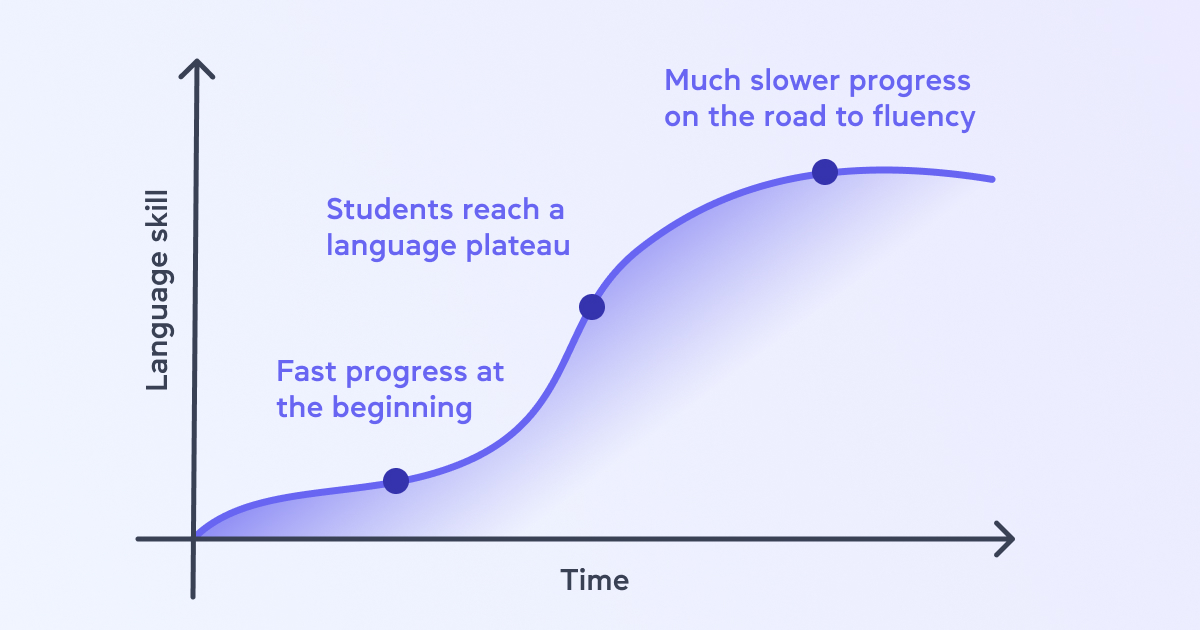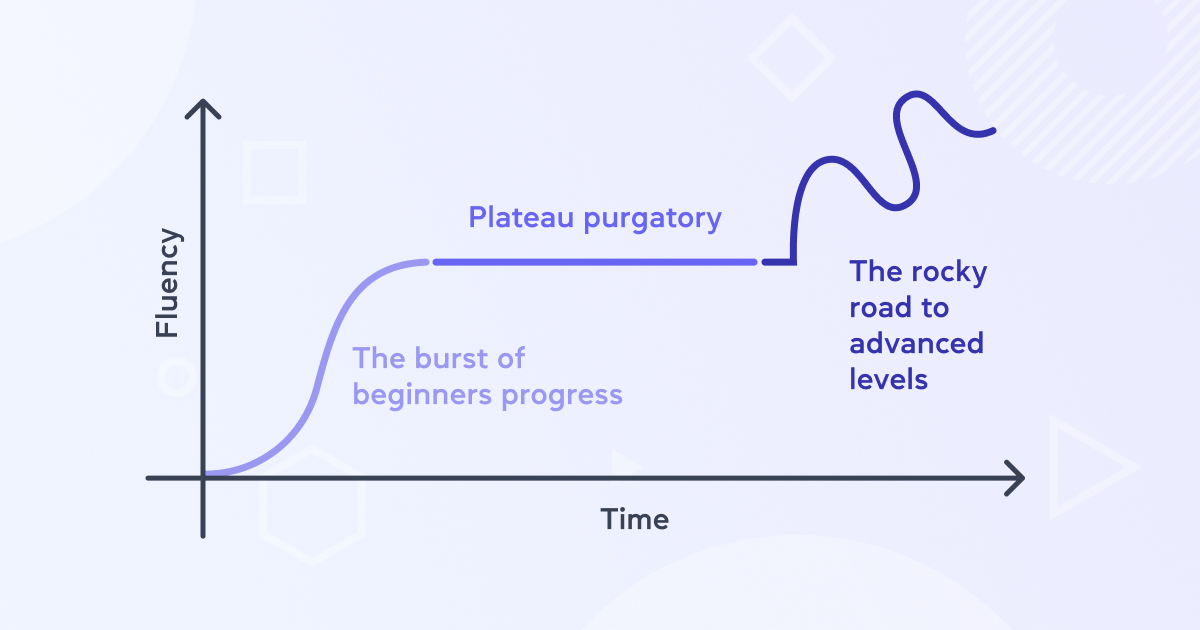Why do we need to teach writing?
- Writing
- IELTS
- Cambridge English
- Teaching qualifications
- Activities
- Tips & Strategies
- Methodology

09.10.2023
Have you recently noticed that your students who had outstanding performance and good progress before started losing motivation? Do they seem upset or unsatisfied with the results? Are they wondering how to move forward? If these are your cases, this article is for you.
We are about to discuss the causes of such situations, the most common and serious of which is reaching a language plateau.
How to become a motivation guard?
A language learning plateau occurs when a person believes their learning speed has decreased.
The thing is when someone first starts learning a language, they often make rather quick progress from nothing to something. It’s not surprising as the desire to study is at its highest point at this stage. So, if the person has enough practice, they will soon feel that they are moving somewhere.
However, after passing the easiest twists and turns, they realize that they must work twice as much (if not more!) to see any development towards fluency, as it takes a much bigger amount of effort to still move on.
This is what we call a language plateau, which may make the route to language mastery seem overwhelming or even impossible, as the feeling of stagnation and lack of visible results leave students with almost zero motivation.

Transform your teacher talk
Say goodbye to boring lessonsThat, of course, makes reaching language plateaus a painful experience not only for students but for teachers as well.
By the way, plateaus are common in many other fields beyond language learning: according to Dr. K. Anders Ericsson, hitting a plateau is normal in any skill growth (not only language learning). Mastery occurs in bursts rather than in constant linear growth.
We may go even further by saying that people do not actually reach a plateau. Even though they believe they have reached some kind of a dead end, they are still actually moving, but at a much slower pace.

Here are some common signs that your students have really reached the language plateau:
How to boost students' motivation?
Now that we know “the symptoms”, it’s high time to find out about the reasons for the language plateau to exist. Here are some common factors:
The first explanation for the sense of stagnation is that people’s perceptions of the word “progress” change over time.
For example, the initial advancement at the early stages is much simpler. Of course, it is easier to feel that you are progressing when you move from being absolutely illiterate to having the capacity to communicate on basic topics and express your opinion on a simple level.
In other words, the first thousands of words that give you a chance to recognize almost 80% of the things that you see and hear in everyday speech feel like greater progress than going from five thousand to six thousand vocabulary units.

Yes, students pay the same amount of effort; however, it just feels different: the language and grammar are very specific, and being able to acquire one more little percent of text coverage doesn’t feel like such a big deal in comparison with the 80% that they used to have.
Learning when all of the fundamentals have already been discovered feels like a very unproductive use of time, because all progress is now measured in quality rather than quantity. Your students seldom learn how to articulate new ideas, but rather how to convey existing ones in more subtle or efficient ways.
Here is where a teacher has to explain that such a situation is natural and the students will never be able to move as fast as they once did at the very beginning.
However, it doesn’t mean that they do not progress at all.
How to teach English to beginners?
Furthermore, once your students get to the intermediate level, they have to work in two directions: the first one is to continue working on gaining new knowledge and the second is to make sure that they don’t forget the information they have already learned and don’t make any mistakes.
So, at this stage, efforts are also made to reduce mistakes, in addition to learning new words and grammar topics. Everyone would agree that this situation is not as inspiring as the one where students didn’t have to revise anything because they knew nothing and therefore were learning something new all the time.
On the other hand, your students knew nothing, which is why they didn’t have to revise the stuff. But having something to revise is already a great achievement, isn’t it?

Another explanation for the intermediate plateau’s presence is that both the quantity of information and the amount of time the student needs to spend to master this information increases from level to level:
| Difficulty | Level | Time |
| Beginner | A1 | 70 hours |
| A2 | 180–200 hours | |
| Intermediate | B1 | 350–400 hours |
| B2 | 500–600 hours | |
| Advanced | C1 | 700–800 hours |
| C2 | 1000–1200 hours |
As you can see, it is much more complicated to move from C1 to C2, for example, than to reach A2. Not everyone is ready for such a significant growth of commitment and still expects changes after every hundred of hours.
That is why an ESL teacher has to explain that taking more time to move from level to level after the intermediate stage is natural and doesn’t mean a decrease in performance.
At this point, students have to be both hardworking and patient and they shouldn't expect drastic, instant changes.
How quickly can we learn English?
Finally, the intermediate level can be reached without stepping out of the classroom.
However, advanced levels must be learnt through applying the language in real-life circumstances. In other words, one should modify their daily routine to incorporate this new language.
The reason is that the classroom is a small and tightly regulated setting.
Students can’t possibly experience all the possible scenarios and learn how to deal with them by staying in the comfort zone of their classroom.
That is why reaching a language plateau may also be a sign to incorporate more authentic materials and encourage students to use every chance to actually practice outside the classroom.

Now we know everything about the language plateau, but the main question remains the same: what can you as a teacher do to help your students overcome a language plateau?
Let’s look at some tips:
When reaching this hard period of time, it is crucial for a student to have a goal that will lead them through all the hardships and challenges.
Simple goals (like “I want to sound cool” or “I want to impress my boss”) and basic goals (like “I want to be able to say at least something abroad”) are either not serious and inspiring enough (like the first set of examples) or even fulfilled (like in the second example).
Reaching a language plateau is the time to review the goals and talk about why your students need to move on and whether they really want to. An important goal doesn’t let students drown in their sadness and lack of motivation and makes them overcome even such serious obstacles as a language plateau.
Tips to set the aims effectively
Once you start spotting the signs mentioned above, you have to consider making tasks more challenging and diverse.
Make sure the activities require students to use not only listening or reading but a combination of skills, which is much more realistic when it comes to everyday situations. Students are capable of doing much more than they could at the beginning, so don’t let the repetitive and uncomplicated tasks demotivate your students and make them feel as if they reached their full potential.
The comfort zone is a very unwanted thing at this point.
By this time, students have already chosen their favorite “area” of language, which they definitely try to improve with a greater effort just because they feel much more comfortable doing that than struggling with the sphere they have problems with. It is a psychological trick that is true not only for language learning.
Take the gym as an example! If the person feels powerful exercising their legs but dies every time it comes to the abbs, guess what they would choose to do with greater pleasure?
The teacher’s task here is to make sure that students don’t stick to their comfort zone and do not ignore their least favorite parts of work.

Moreover, the teacher has to pay special attention to the fossilized errors and make them a target of further practice.
Sometimes it happens that intermediate students keep struggling with some basic grammar (correct comparative and superlative structures, for instance) which prevents them from reaching fluency.
Well, the intermediate level is a high time to reduce fossilization to the minimum.
More about typical grammar structures for each level
Consistent practice is a key factor in overcoming a language plateau.
At this point, it’s not enough to practice from time to time.
If your students want to reach fluency, they have to make English an integral part of their life and routine and interact with the language on many different levels, not only while completing the hometask or sitting in the classroom.
How to do that? Let’s move on to the next tip!
As your students reach a language plateau, it is high time to increase their language exposure as much as possible.
Coursebooks are not enough anymore at this point because your students need to start seeing the things they learn in the real context.
The most accessible way to increase the students’ exposure is through extensive usage of authentic materials like TV-shows, blogs, movies, books, music and actually anything that goes beyond that one textbook that you have.
Encourage students to look for authentic materials that suit their interests and tastes. Embrace their independence through the individual search: you can't be the only source of materials for your students anymore.
Ideally, students should also communicate with native speakers at this point. So, maybe it’s worth looking for a local speaking club or some kind of international online initiative that allows students to practice with native speakers.

Last but not least, don’t let your students feel unmotivated and upset.
Talk to them about the concept of language plateau, share the tips on how to pass this stage, encourage them to embrace their love and genuine interest in language by showing how much you love it and are genuinely interested in it.
Look for the word of the day, interesting and beneficial TV-shows, some cool short stories, etc. Persuade your students that learning a language is a lifestyle, not a chore that needs to be completed and forgotten.
Tips to use authentic materials
As you can see, the language plateau is not a failure, a disaster or a result of ineffective teaching practices. Vice versa, it is a common and absolutely normal process that sooner or later all the ESL teachers have to deal with.
If you find yourself in this situation, make sure to build the right strategy and adapt to the situation using the tips mentioned above.
Also, don’t hesitate to ask other professionals for help. Chances are, your fellow colleagues may also deal with the same problems.
As for now, let’s answer a couple of questions to sum up the topic.
Teachers should implement more authentic materials when they spot the signs of reaching the language plateau.
Arina Kravchenko
Author
Teacher of General English & IELTS
Comments
Leave your comment